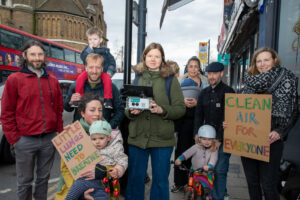Breathe London award final round of air quality monitors to 20 more community groups
In the third and final round of the Breathe London project, another 20 community groups have been presented with air quality monitors to arm themselves with information in the fight for healthy air, taking the total awarded during the scheme to 60.
When Breathe London began in 2018 it was intended as a one-year programme jointly run by the GLA alongside C40 Cities and was primarily financed by the Children’s Investment Fund Foundation (CIFF).

When the CIFF funding for the project ended, the Mayor secured more to continue the programme, which led to it becoming what it is today.
These days the network is run by the Environmental Research Group at Imperial College London (who also run the London Air Quality Network) along with the American air quality sensor company Clarity. Bloomberg Philanthropies have also supplied funding to the project.
The current incarnation of Breathe London began in 2021 when it was became known as the Breathe London Community Programme. In round one, ten local projects were provided with air monitoring sensors.
Among these was Lydia Fraser-Ward in Redbridge, who installed hers in a children’s playground where she had spent a lot of time during lockdown. ‘I am deeply concerned by the effects of air pollution on health, and that is why I was so keen to support the campaign to have an air-quality monitor installed. The playground is set in lovely parkland surroundings but it is also close to the A406, which has very high levels of vehicular pollution.’
The benefits of the Breathe London scheme to the community groups are many, but being backed by Imperial College’s Environmental Research Group is chief among them, lending them credibility when they present their data to local authorities.
Imperial’s Andrew Grieve explained: ‘Local authorities are now increasingly faced with this… people buying sensors off eBay and taking their data to them and saying ‘this is our data, now we want you to do this.’ And authorities are faced with a dilemma – ‘it’s not regulatory monitoring data, but we still have a group of passionate residents here who want to do something, how do I present this to the transport team or the environment team?’
‘The reliability of this new generation of small, inexpensive sensors can be compromised by changes in temperature and humidity and different particle make-ups so to counter that we ensure that our monitors are co-located alongside reference stations before being taken into the field. We also have 19 Clarity sensors at reference stations permanently. We look at how they are performing versus the reference station every hour, then apply a correction factor to the rest of the network. That dramatically improves the data quality.’
There is also an argument that these smaller, cheaper monitors are complimenting the existing system, not undermining it. Andrew again: ‘The rules about where regulatory monitors have to go are very specific. They’re set out in the technical guidance which is updated every two years or so. But they are very specific for good reason: data from one local authority is comparable to another because they’re all buying the same types of monitors and following the same siting criteria.
‘These small sensors can fill in the gaps in between, either in places where you can’t physically get a reference monitor or if it’s for a specific community concern that wouldn’t warrant putting in 25 grand’s worth of equipment.’
As the final round of recipients were announced, Dr Ben Barratt, Reader in Environmental Exposures & Public Health at Imperial, said: ‘The passion and energy shown by the 40 community groups already supported in this innovative programme is inspiring. We have already learned so much about the importance of clean air to communities and I’m delighted that a further 20 groups will be empowered to generate their own local evidence and impact.’
Shadi from the Willesden Green Town Team, one of the groups selected for this round, said: ‘The Breathe London Node will be an incredibly important resource for Willesden Green Town Team in our drive towards tackling air pollution in Willesden Green. While we know anecdotally that the area suffers poor air quality as a result of heavy traffic congestion, construction and other light industry, we are lacking more scientific evidence.
‘The Breathe London Node will provide data that will enable us to better understand the problem, lobby for change and tackle it more effectively through our greening and other targeted projects, for the wellbeing of the entire community.’
To read more about the project and the groups who have taken part in it, visit: www.breathelondon.org.

















